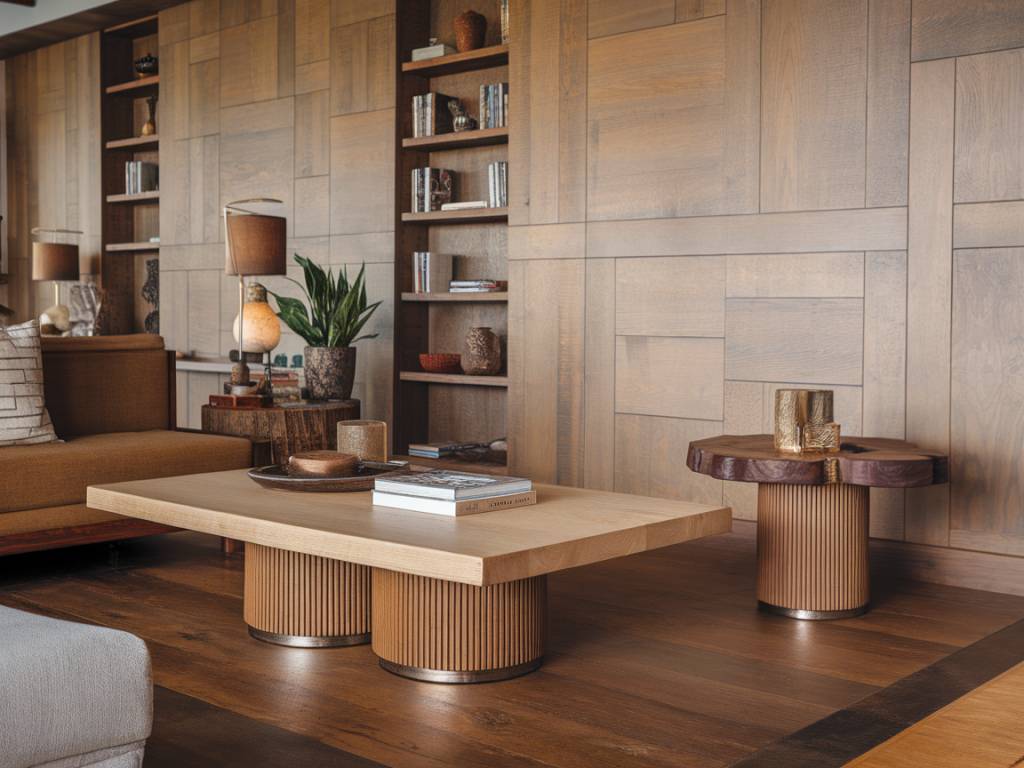Discovering the Harmony in Mixing Wood Tones
As I sit in my cozy living room, warmed by the gentle aroma of sandalwood diffusing softly through the air, I can’t help but marvel at the delicate dance of wood tones surrounding me. There’s magic in combining different wood finishes—a magic that transcends mere aesthetics and taps into our sense of authenticity and comfort. Mixing wood tones can feel as daunting as a tango for two left feet, but it doesn’t have to be. Let’s delve into this delightful blend of art and science, as we explore how different finishes can coexist seamlessly within your home.
The Case for a Mix
Why settle for a single note when you can have a symphony? Using a mix of wood tones adds depth and character to your space. Have you ever walked into a room that felt flat, almost lifeless, despite being impeccably furnished? The truth often lies in the monotony of matching woods. Conversely, adding contrast and variety through different finishes can create a space that not only enlivens the senses but also feels grounded and genuine, almost like crafting a tale through timber.
Find Your Anchor
Establishing a dominant wood tone, or an anchor, serves as the foundation upon which other elements will build. Think of it as a lead character who naturally draws attention but allows others to shine in their moments. Whether it’s your flooring or a grand dining table, this dominant wood should account for roughly 60% of the room’s wooden textures.
If you’re drawn to the rich hues of walnut for your floor, let it be your anchor, setting the mood and color palette of your room. It’s not about trying to match everything to it but allowing other tones to complement and contrast in a harmonious way.
Diversifying Your Tones
Once you’ve anchored your space, the beauty lies in how you diversify. Picture this: a weathered oak coffee table paired elegantly with light ash bookcases. The key is balance and proportion. Here’s how to achieve it:
- Contrast with Care: Dark woods crave the juxtaposition of lighter counterparts. If you’ve committed to a dark mahogany for larger pieces, balance them with softer beech or maple accents.
- Echo Undertones: Woods within the same shade family create flow. A cherry wood with warm, red undertones will sing beautifully alongside a cedar with similar notes.
- Introduce Neutral Buffers: Incorporate neutral elements like a sisal rug or a beige sofa. They act as visual breathers, bridging diverse wood tones seamlessly.
Remember, the eye delights in continuity and surprise in equal measure. Invite diversity without disrupting harmony.
Telling a Story with Texture
Have you ever run your fingers across an old family heirloom, feeling its story engraved through every groove and blemish? Texture imparts personality to wood, offering a sensory layer beyond color. A smooth, polished walnut dresser might whisper elegance, while a reclaimed barnwood shelf tells tales of rustic charm. Mixing these textures is akin to weaving an intricate tapestry that invites touch and interaction.
Blending the sleek with the rugged brings an inviting, lived-in comfort to your space. Perhaps a glossy mahogany sideboard complemented by rugged oak picture frames will strike just the right chord.
Embrace the Unpredictable
Sometimes, it’s the unexpected partnerships that leave the most lasting impressions. Have you ever paired something old with something new and found an enchanting marriage of styles? Wood finishes work similarly. Don’t shy away from combining a vintage teak stool from a flea market find with your contemporary pine desk. Therein lies the allure—a testament to your personal story, an embrace of both history and modernity.
Consider embracing a playful spirit when it comes to smaller, functional pieces like end tables or plant stands. These elements are easily replaceable if you crave change, allowing for an ebb and flow that mirrors life’s unpredictability.
A Little Goes a Long Way – Accessorize!
Accessories are your best allies in knitting together disparate tones. Have you thought about how a herringbone throw or woven baskets can subtly link the varied finishes of a room? Picture this: a wall adorned with circular mirrors, bouncing and reflecting light to create a unity of space and tone.
Including wooden accessories in varied finishes—picture frames, sculptures, or even lamp bases—can echo the tones within your primary pieces, acting as bridges across your room.
Caring for Your Collection
The beauty of wood lies not only in its aesthetic appeal but in the warmth and serenity it brings to our interiors, almost as if breathing life into the very air we inhabit. But this beauty needs nurturing. Regular care and attention ensure that each piece remains vibrant and connected, contributing to the harmonious rhythm of your home.
Allow yourself the pleasure of polishing these cherished surfaces, indulging in the natural symmetry of grain, and embracing the character of each knot and imperfection. It’s here—among the understated elegance of diverse wood tones—that the heart of your home truly shines.
In your pursuit of mixing wood tones, may you find joy in the unexpected harmonies and the stories each piece narrates within your curated sanctuary. Let these stories unfurl with authenticity and warmth, just as the heart of your home should.



